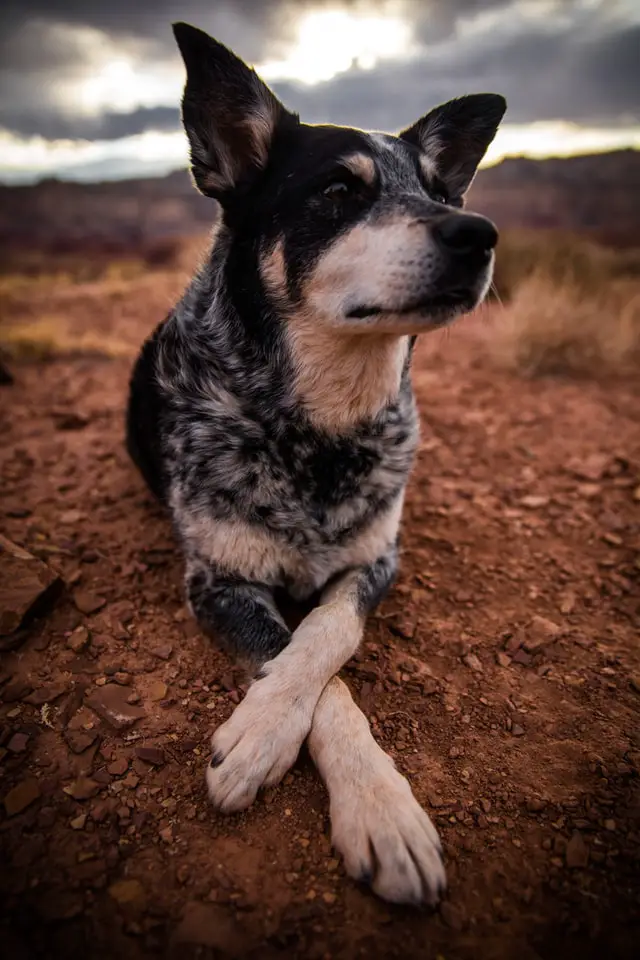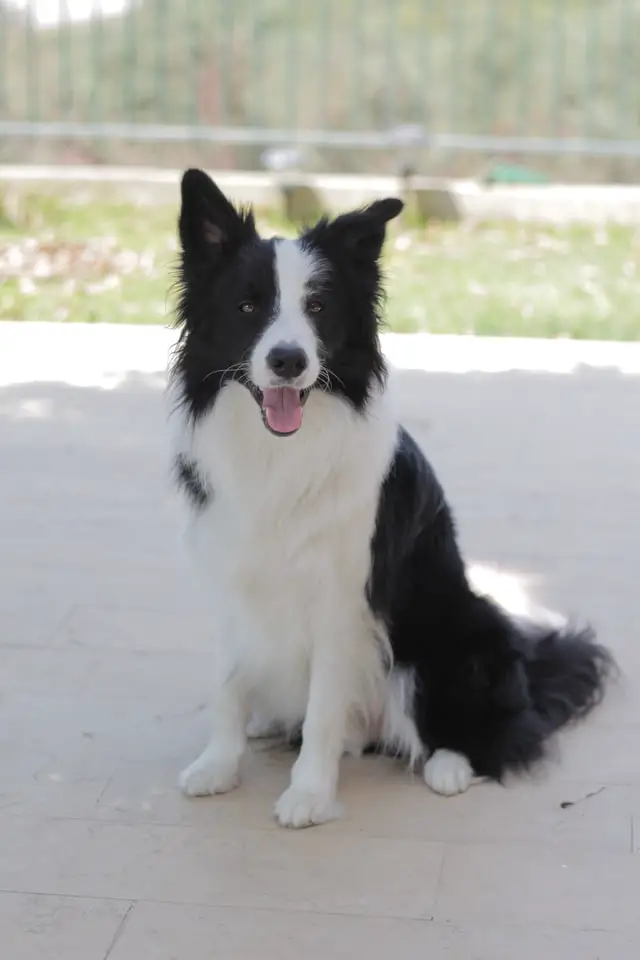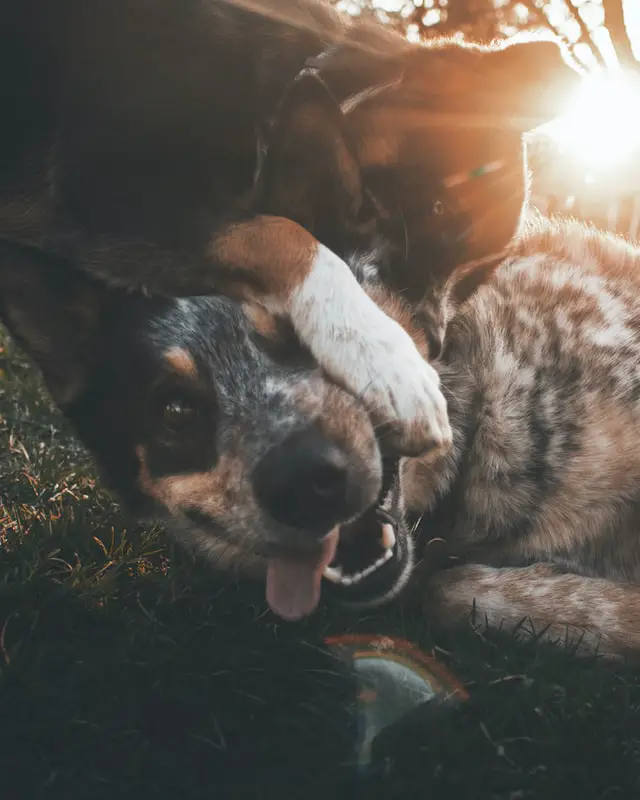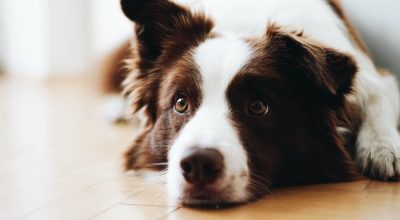Border Collies as well as Blue Heelers are dogs well-known for their friendly personalities and never-say-die attitudes. However, they aren’t necessarily the best dog type for all families. These breeds have a lot of things in common, but there are also a lot of things that separate them apart. Let’s see what things these herding dogs make them alike and yet so dissimilar!
History of Blue Heeler and Border Collie
The development of Border Collies happened in Northumberland to herd sheep. They are famous for their fierce stare when it comes to commanding the sheep entrusted under their care. It wasn’t until 1915 that the authority coined the term Border Collie. The purpose for this was for the dog’s registration as a different dog species from the other Collie breeds that were already on the books.

Meanwhile, the birth of the Blue Heeler began when George Hall landed in New South Wales in 1802 and established two cattle farms. He started hunting for an actual driving dog, including the blue mottled hound, to help him move his huge numbers of cattle to Sydney’s markets. The breeding of the dogs occurs with dingoes, and the Halls utilized the Halls Heelers by 1840. Their name was a product of inspiration from the hounds in Thomas Hall’s novel ‘Heelers.’
Characteristics of the Australian Cattle Dog versus Border Collie
A Border Collie is a fantastic working dog breed that is extremely beneficial to farmers. With their boundless strength and motivation, they would gladly work all day if presented with the opportunity. They are attentive to their owner’s wishes, which they owe in part to their intelligence. Give your great pet amount of kisses, attention, and tasks, and you’ll have a lifelong friend.
A Blue Heeler is a dog that is both intelligent and responsive. They are playful, friendly pet that are wary of strangers, which is why they end up making such an outstanding guard dog. This dog breed is headstrong, self-reliant, and tough. They require a solid owner that is full of care and compassion, and you will have a loyal companion.
Appearance of Blue Heeler and Border Collie
Despite the fact that both dogs have medium-sized frames, several physical variations still exist to consider while comparing them.
Border Collies have a muscular frame. The alert gaze and revealing ears of this canine make it easy to identify. This fido has a double coat that is soft and fluffy.

The topcoat is usually coarse and can be flat or wavy. Compared to the outer coat, their undercoat seems to be velvety and shorter. Border Collies usually have white and black features, although they can also have a range of coat colors, such as blue merle, and tan and white combo.
On the other hand, a Blue Heeler has a more robust and compact frame. It’s a tough dog capable of herding livestock across great territories. A large head and powerful shoulders are also some remarkable features of a Blue Heeler. This canine has a deep undercoat and a short outer coat. Red or blue patches containing brown, black, or blue patterns are common on the coat.
Personality
Border Collies have a strong drive to learn new skills and orders on a regular basis. Your imagination is the only limit. In less than 5 repetitions, they grasp and retain new commands. Their obedience for the initial order is 95% of the period or better.
Border Collies are a fun-loving breed that is easy to train. This breed’s emotional intensity mimics that of their owners, and they do not respond well to punishment.
Blue Heelers are also intelligent. In 15 to 25 repetitions, they comprehend and absorb new commands. This dog quickly learns the link between instructions and actions. The Blue Heeler is a breed that loves to play. You’ll know it’s ready to play when you hear excited barking and biting.
Comparison Table of Border Collie versus Blue Heeler Characteristics
| CHARACTERISTICS | BORDER COLLIE | BLUE HEELER |
|---|---|---|
| Intelligence | Exceptionally intelligent | Highly intelligent |
| Activeness | Extremely athletic | Exceedingly active |
| Mentality | Highly trainable | Independent thinker |
| Obedience | Obedient | Strong willed |
| Loyalty | Loyal | Very loyal |
| Body build | Hardy | Sturdy |
| Protectiveness | Highly territorial | Protective of family members |
| Relationship towards owner | Loves playing games with their owner | Bonds strongly |
| Playfulness | Play fetch for long hours | Always looking for a job even playing fetch |
| Exercise requirements | Always hungry for exercise | Thrives on vigorous exercise |
| Performance | Escape artist | Vigilant watchdog |
| Destructive behavior | Can develop destructive behavior without exercise | Destructive when bored |
| Herding attitude | Chasing all moving things | Chase moving things |
| Nipping behavior | Nipping behavior is challenging to stop | Will nip children and animals |
| Socialization | Requires lot of socialization | Aggression toward other animals |
Temperament of Border Collie versus Blue Heeler
Both breeds are members of the herding family. They prosper in a stimulating setting with lots of social interaction. These breeds are extremely faithful and believe like there are always some tasks to perform. It is your responsibility as a fur parent to give these herding canines activities, hobbies, and obstacles that are appropriate for their temperament.
The Border Collies make wonderful family pets, but they can be hesitant around strangers. They’re among the most intelligent dog breeds, as well as being incredibly affectionate. But instead of playing the games you instruct them, they frequently create their own.

Being high-energy canines, Blue Heelers require constant stimulation. These dogs might get bored. If there is no appropriate training and stimulation, they may develop destructive behavior. They are prone to outwitting their handlers and like exploring different games.
Both breeds are devoted animals, but when intruders are present, they can safeguard their owners to protect them.
Training & Exercise of Border Collie versus Australian Cattle Dog
Both of these dogs are clever animals who respond well to instruction. They are both adaptable to new commands and respond well to training.
Border Collies are famous for their intense focus on their work. Finding a dynamic equilibrium across obedience, simulation, and training is critical.
Agility training is a fantastic alternative because it allows them to stay active whilst also learning new skills. Without sufficient training and stimulation, Blue Heelers seem to be more inclined into becoming bored and developing bad tendencies.

Another crucial part of training is socialization. Border Collies might be shy, but with proper socialization, they can overcome this. Blue Heelers, who can be very protective of their owners, require more socialization.
Both breeds require a lot of exercise due to their high levels of activity. To be fit and happy, both dog breeds require physical and intellectual activities. They enjoy being outside and consider exercise being a means of engaging with their fur parents.
Border Collie parenting needs you to exercise him for 90 minutes every day. Some dogs require up to 2 hours of workout per day. Take out your dog for a walk, train him on agility, or introduce your pet to new games.
Every day, Blue Heeler requires exercising for a couple of hours. You could perhaps take your dog on a hike, play games with him, or provide a training program. Also, you can look for other things that will provide stimulation to this fido.
Taking Care of Border Collie versus Blue Heeler
Although these dog breeds share the same umbrella as herding dog, there are still some differences when it comes to their personality, health, and needs. Meaning, they both require specific attention and care.
Grooming
Despite the fact that both dogs shed, none are considered a high-maintenance pet.
Border Collies have a lengthy, filthy, and tangled exterior coat. To avert dead hair and prevent shedding, brush their coat twice a week. The brushing requirement is on a daily basis, and bathing is per 2 months or so.
Blue Heelers require very little care. These canines have a short, dirt- and water-resistant outer coat. Once or twice a week brushing is a requirement of a Blue Heeler, and they will blow their coats 2 times a year, necessitating further brushing.
Puppies
Despite the fact that most people understand the basics of housebreaking a Border Collie puppy, it is indeed a typical problem among owners. Stopping your dog from peeing inside is a particularly critical issue. To begin, walk your dog 15 – 20 minutes every after meal and at minimum 4 – 6 times throughout the day. Make sure to commend him for going outdoors in doing his business.

When you first bring your Blue Heeler puppy home, you should begin teaching him straight immediately, and training must always be based on positive reinforcement. “Sit, lay, come, stay, and leave it” are five essential orders to keep your Blue Heeler under control.
Health of Border Collie versus Australian Cattle Dog
When it comes to health, there are no notable distinctions between the Border Collie and Blue Heeler. Although both types can have minor health difficulties, these dogs are more hardy compared to the other dog breeds and seldomly have significant health problems.
Diet & Nutrition

A high-intensity breed, the Border Collies require additional fat and protein. Choose high-quality dog foods with easily digestible dietary protein, such as salmon or lamb. Search for carbs that are good for them, such as oatmeal and peas. Border Collies require two meals every day on average.
Blue Heelers share identical dietary requirements. Raw food diets, which include raw meat, brown rice, and raw fruits as well as veggies, are popular among some fur parents. A regular kibble meal is a decent alternative unless your dog is really active and performs all day.
Supplements should be regularly consumed by both dog breeds. Crushed eggshells are high in calcium and are beneficial to both dogs. If your dog is at potential for developing hip dysplasia, a glucosamine supplement may be beneficial too.
Health Risks
Seizures, hip dysplasia, progressive retinal atrophy, a heart abnormality, and some eye diseases can all affect Border Collies. In comparison to other dogs, this breed can be more susceptible to develop compulsive behavior.
Hip dysplasia, deafness, and progressive retinal atrophy seem to be the most common health problems among Blue Heelers. The recessive piebald alleles are also common to them which have been associated with genetic deafness and can cause white skin and coat.
Lifespan
The lifespan of a Border Collie is 14 years old or longer if they are in good health. Yet, as mentioned earlier, there are a few canine conditions that are more prominent in this dog breed. So it’s a good idea to be knowledgeable that something will go wrong, even if it’s a little bit unnecessary with proper care.
The same goes with that of a Blue Heeler that also has several genetic disorders that you should be aware of. Despite those dog ailments, this dog breed is fit and active and can live up to 15 years.
Which One is Right for You?
Differentiating the Border Collie and Blue Heeler will end you knowing two of the intelligent herding dogs that are incredibly loyal. These two dogs are suitable for fur parents who are willing to devote a lot of time, energy, and socialization to them.
Border Collie and Blue Heeler creates excellent family dogs since they require little maintenance, have few significant health issues, and live a long time. If you can meet their energy needs, any of the two can be an excellent furry friend.


